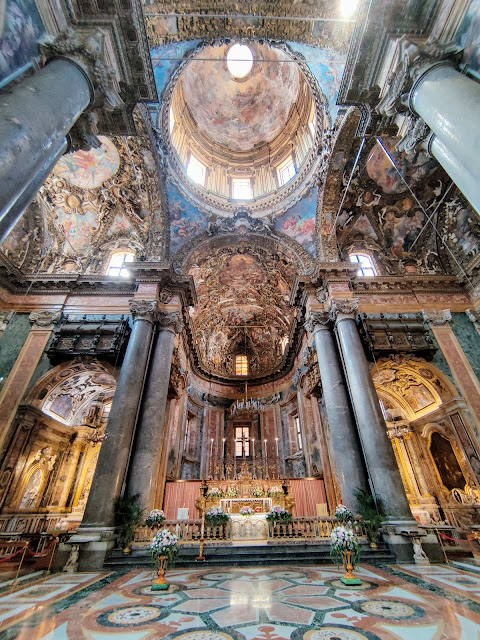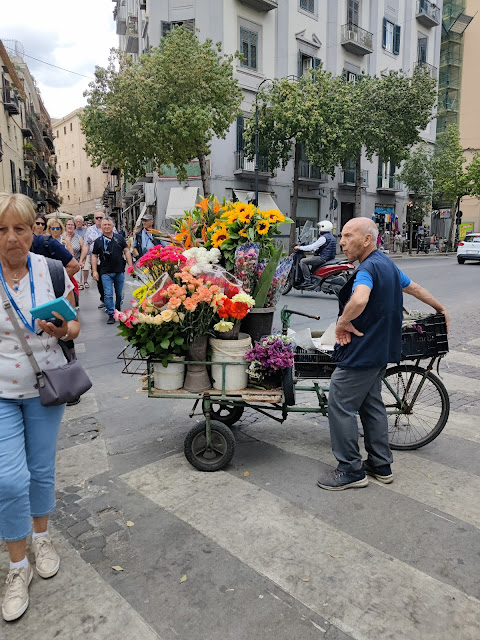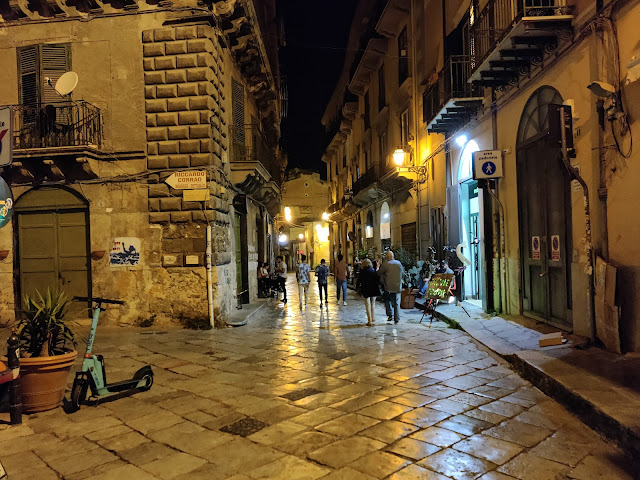As a lover of excessive Catholic church decor, when I was in Sicily I was in heaven, so to speak. Take the Church of Saint Mary of the Admiral, so called because it was originally built in the 1100s under the patronage of the Syrian Christian admiral who served the Norman king, Roger II. The church's charter was in ancient Greek and Arabic and today it is part of Italo-Albanian Catholicism and its practices follow the Eastern Orthodox Church.
The mash-up of styles and the density of ornament and meaning are breathtaking. Almost horrifying.
 |
| The visual equivalent of eating too many Sicilian pastries. |
The church's mosaics, statues, and ornaments pay plenty of homage to the divine, but the secular power gets its due as well. Below is King Roger II being crowned by God himself.
Our wonderful guide, Francesca (about whom more later), pointed out that whereas Roman Catholic doctrine preaches that Mary ascended to paradise in corporeal form, the Eastern rite holds that only her soul ascended. So the mosaic below shows God (who is also Jesus) at Mary's deathbed lifting her soul (represented as a baby, as Jesus once was) up to heaven.
 |
| Mother and child reunion. |
The church is also known as La Martorana, after an aristocratic 12th-century nun of that name whose convent adopted the church in the 15th century. Right next door, and at the other ornamental extreme, is the little Church of San Cataldo. In the photo below La Martorana is on the left, San Cataldo on the right, topped by three red domes.
It's an Arab-Roman church and those red domes led me to expect dazzling Moorish-style decoration. After I paid the two-euro entry fee and stepped through the curtain concealnig the interior from non-ticket-holders, I discovered that San Cataldo is both tiny and almost completely bare.
 |
| Those red domes are disappointingly plain inside. |
I didn't see San Cataldo's simplicity replicated in any other church I visited. La Martorana was much more typical. And for all its extravagance, it was outdone by the Duomo in Monreale, a town just south of Palermo. A similar mix of East and West, Byzantine and Norman, the Monreale cathedral's interior is even more stunning, being completely covered in glittering mosaics.
 |
| The panels above the arches tell the story of Noah and the ark. |
Looming over all of it is a gigantic depiction of Christus Imperator, Jesus/God as ruler of the world.

O,
\Imagine the impression this must have made on the peasants and artisans from the surrounding countryside, people who barely had roofs over their heads, when they entered the Duomo for the first time and saw God glowering down at them.
While we were there a wedding erupted. The guests were gorgeously arrayed, but their finery was put to shame by the venue.
A side chapel erected by some bishop or other seemed to take the opulence of the Duomo as a challenge. "You think that's ornate? I see you and raise you." Ornament crammed on top of ornament, everywhere you look...it's claustrophobic. I loved it.
There's the bishop on the left, admiring Christ's genealogy. On the right, the statue of a woman suckling one infant and offering a breast to a second is a standard symbol of Charity, often seen in these symbol-crammed houses of worship. Bishops seemed to be especially keen to be honored posthumously for their charity.
Another gorgeously ornate pile we visited was the Duomo in Cefalù, a seaside town near Palermo.
 |
| That's the Duomo at the top of the piazza. |
It too had a giant Christ looming over the altar, and plenty of gew-gaws, but it looked almost austere compared to Monreale.
One of its charms was another bishop's funerary monument depicting him dispensing clothing to a half-naked man with a crutch while two children beg for alms. The blanket or simple shift the bishop is providing is notably minimal compared to his own luxuriant satin-and-lace outfit, and he doesn't seem to have anything for the two children, but I suppose beggars can't be choosers.
This and many other things in Sicily's churches brought to mind a passage in Lampedusa's wonderful novel,
The Leopard. It's set in Sicily, still a feudal backwater in the 1860s when Garibaldi and his allies are in the process of overthrowing the old order. After the dust settles Sicily will be unified with the rest of the newly created nation of Italy, and the country will be modernized (sort of) by empowering the mercantile and industrial North. At one point the novel's princely protagonist assures himself that "this is a country of arrangements" and that all the upstart middle class wanted was "to find ways of making more money themselves." They don't want to destroy us aristocrats, he decides, just gradually insert themselves into our places. Nothing would really change.
But when the prince tries to share this consoling insight with his confessor, the priest is outraged. "Briefly, you nobles will come to an agreement with the Liberals, and yes, even with the [anti-clerical] Masons, at the expense of the Church," he protests. "Then, of course, our property, which is the patrimony of the poor, will be seized and carved up among the most brazen of their leaders; and who will then feed all the destitute sustained and guided by the Church today?"
The priest's prediction was accurate, for much of the Church's property was seized in the wake of unification, and while the Church had done little to relieve the misery of the poor, neither did the bourgeoisie once they came to power. The result was the emigration of millions of desperately poor Southern Italians in the decades after unification and, later, the rise of fascism.
The glory of Sicily's churches is inextricably intertwined with the notion that the vast, really obscene wealth of the Church and its leaders--flaunted in every marble sculpture, gold reliquary, and gem-studded chasuble--was justified and even sanctified because it really belonged in some ultimate sense to the poor, to the people whose misery and exploitation made all this horrible, wonderful beauty possible.
Of course that's not the only story these churches tell. However corrupt the institution, it is also a vessel for the spiritual seeking that so often animates our species. Out for a walk I randomly stepped into another church, not a famous one, San Giuseppe dei Patri Teatini. It was yet another flamboyant monument to worldly wealth and power.
But the church organist was practicing a requiem, while nearby a nun knelt at a confessional. I was reminded that faith, hope, and some of the other virtues also had a place here.
Then a man in work clothes, presumably the sextant, hurried over and interrupted the sister's confession to talk to the priest about some urgent matter. It was an Italian genre painting come to life.
The earthier side of Italian Catholicism was also in evidence at the little Oratorio di San Lorenzo, a few blocks from where we were staying. It was built in the late 16th century by a merchants' guild--the gravediggers' guild, according to our guide, Francesca--and exuberantly decorated around 1700. Francesca said that the guild couldn't afford the expense of marble sculptures so hired sculptor Giacomo Serpotta to deck the place in stucco reliefs. The stucco was mixed with marble dust to give it some sparkle. It's small but stunning.
It is most famous for what's not there. Until 1969 a Caravaggio masterpiece,
Nativity with St. Francis and St. Lawrence (that is, San Lorenzo), hung over the altar, but that year the painting was stolen,
allegedly by the Sicilian Mafia. It has never been recovered, but in 2015 a "high-tech" replica of the painting was installed where the original once hung.
San Lorenzo was a deacon of the early Roman church and ran afoul of the Emperor Valerian when he demanded that Lorenzo turn over all the church's riches to the imperial treasury. Lorenzo instead gave away as much of the church's wealth as he could gather to widows, orphans, and other indigents, and when Valerian's emissary demanded the goods Lorenzo reportedly presented him with a crowd of the poor and sick, saying that the suffering masses were the true wealth of the church. Once again, "the patrimony of the poor."
In retaliation the emperor ordered that Lorenzo be roasted to death. (The grill depicted by Serpotta, shown below, looks exactly like the one we saw in an old-fashioned restaurant a few years ago, where we enjoyed some excellent grilled veal chops.) Today San Lorenzo is the patron saint of cooks, because of the grill, and of comedians, because before he expired he is supposed to have said, "I'm done on this side, turn me over!"
 |
| San Lorenzo and his grill. |
Perhaps that's why, despite the saint's suffering, the mood in the oratory is rather light-hearted. There are putti everywhere, and they are not particularly angelic, tussling and taunting each other all over the walls.
The pair below seem to be illustrating a popular Italian saying that translates as "Quit busting my balls."
Speaking of... I spent an enjoyable couple of hours in the Modern Art Gallery of Palermo, housed in a former convent that was taken over by the civil authorities in the 1860s, in the wake of unification. Despite its name, its collection is made up of very traditional work from the late 19th and early 20th centuries, including this large painting from 1898 by Pietro Pajetta.
It's titled
Le gioie della famiglia, which at first I assumed must mean "the family jewels," because gioeilleria is the Italian for jewelry and what else explains the juxtaposition of the pantsless bambino and that carrot? But in fact it's "the joys of the family" that are being celebrated here, apparently including the joys of a good carrot harvest.
In that spirit, the next post will be about the food we enjoyed during our Sicilian sojourn. They eat a lot more vegetables down there than the folks in Emilia-Romagna do, so maybe that painting really is a celebration of carrots.






































